SKODA YETI 2009 1.G / 5L Owner's Manual
Manufacturer: SKODA, Model Year: 2009, Model line: YETI, Model: SKODA YETI 2009 1.G / 5LPages: 271, PDF Size: 16.24 MB
Page 131 of 271
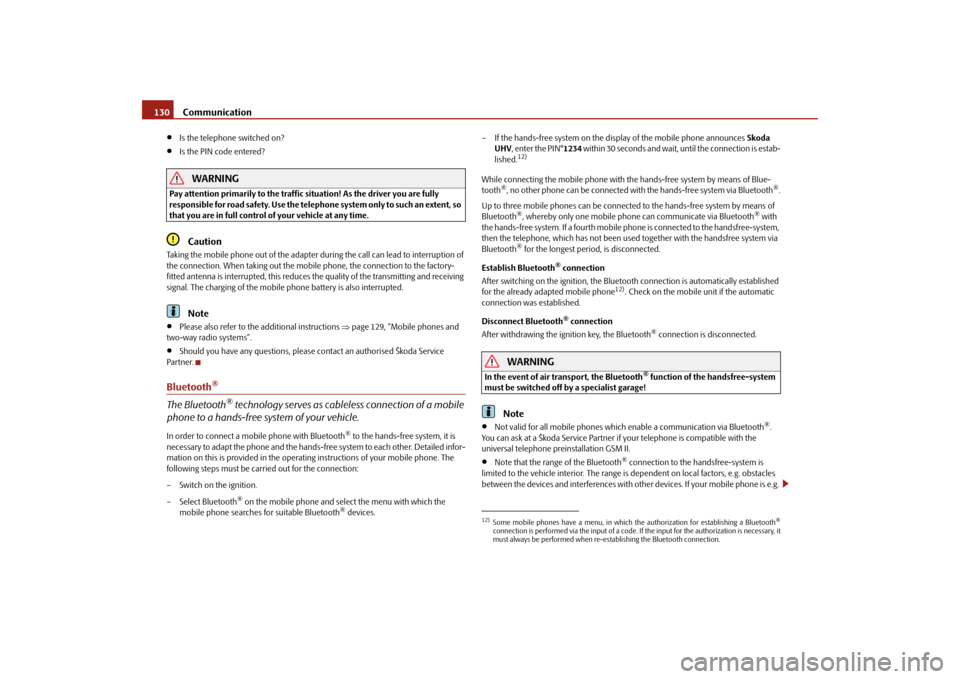
Communication
130
•
Is the telephone switched on?
•
Is the PIN code entered?
WARNING
Pay attention primarily to the traffic situation! As the driver you are fully responsible for road safety. Use the teleph
one system only to such an extent, so
that you are in full control of your vehicle at any time.
Caution
Taking the mobile phone out of the adapter du
ring the call can lead to interruption of
the connection. When taking out the mobile phone, the connection to the factory-fitted antenna is interrupted, this reduces the quality of the transmitting and receiving signal. The charging of the mobile phone battery is also interrupted.
Note
•
Please also refer to the additional instructions
⇒page 129, “Mobile phones and
two-way radio systems”.•
Should you have any questions, please
contact an authorised Škoda Service
Par tner.Bluetooth
®
The Bluetooth
® technology serves as cableless connection of a mobile
phone to a hands-free sy
stem of your vehicle.
In order to connect a mobile phone with Bluetooth
® to the hands-free system, it is
necessary to adapt the phone and the hands-free system to each other. Detailed infor- mation on this is provided in the operatin
g instructions of your mobile phone. The
following steps must be carried out for the connection: – Switch on the ignition.– Select Bluetooth
® on the mobile phone and select the menu with which the
mobile phone searches for suitable Bluetooth
® devices.
– If the hands-free system on the display of the mobile phone announces
Skoda
UHV
, enter the PIN°
1234
within 30 seconds and wait, until the connection is estab-
lished.
12)
While connecting the mobile phone with th
e hands-free system by means of Blue-
tooth
®, no other phone can be connected with the hands-free system via Bluetooth
®.
Up to three mobile phones
can be connected to the hand
s-free system by means of
Bluetooth
®, whereby only one mobile phone can communicate via Bluetooth
® with
the hands-free system. If a fourth mobile phone is connected to the handsfree-system, then the telephone, which has not been used together with the handsfree system via Bluetooth
® for the longest peri
od, is disconnected.
Establish Bluetooth
® connection
After switching on the ignition, the Bluet
ooth connection is auto
matically established
for the already adapted mobile phone
12). Check on the mobile
unit if the automatic
connection was established. Disconnect Bluetooth
® connection
After withdrawing the ignition key, the Bluetooth
® connection is disconnected.
WARNING
In the event of air transport, the Bluetooth
® function of the handsfree-system
must be switched off
by a specialist garage!
Note
•
Not valid for all mobile phones which enable a communication via Bluetooth
®.
You can ask at a Škoda Service Partner if
your telephone is compatible with the
universal telephone preinstallation GSM II.•
Note that the range of the Bluetooth
® connection to the ha
ndsfree-system is
limited to the vehicle interior. The range is
dependent on local factors, e.g. obstacles
between the devices and interferences with othe
r devices. If your mobile phone is e.g.
12)Some mobile phones have a menu, in which the authorization for establishing a Bluetooth
®
connection is performed via the input of a code. If the input for the authorization is necessary, it must always be performed when re-e
stablishing the Bluetooth connection.
sgg.6.book Page 130 Thursday, September 24, 2009 2:32 PM
Page 132 of 271
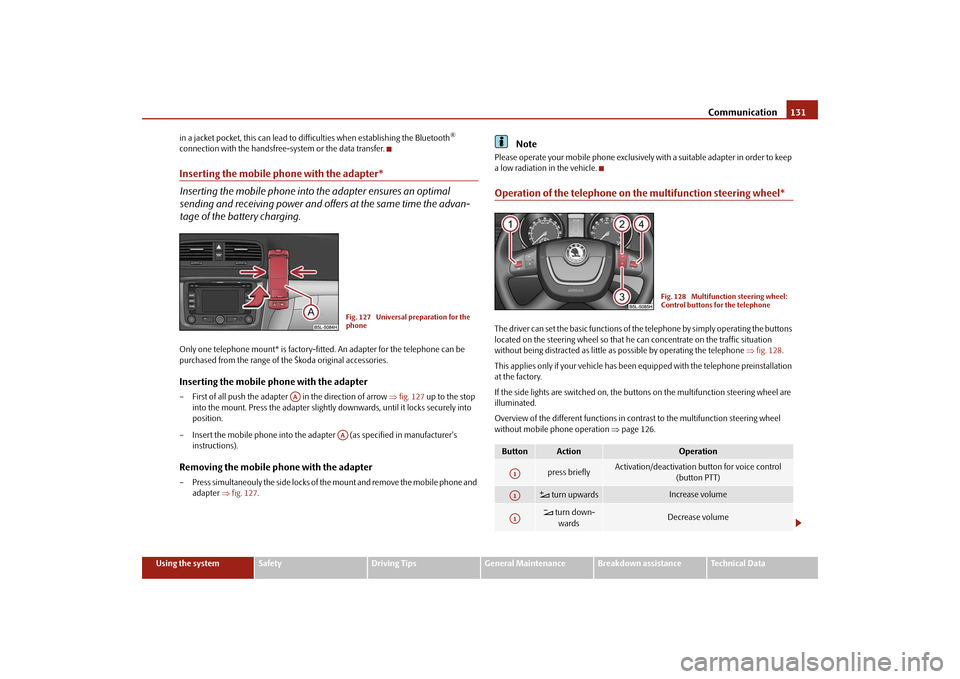
Communication
131
Using the system
Safety
Driving Tips
General Maintenance
Breakdown assistance
Technical Data
in a jacket pocket, this can lead to diff
iculties when establishing the Bluetooth
®
connection with the handsfree-
system or the data transfer.
Inserting the mobile phone with the adapter* Inserting the mobile phone into the adapter ensures an optimal sending and receiving power and offers at the same time the advan- tage of the battery charging.Only one telephone mount* is factory-fitted. An adapter for the telephone can be purchased from the range of the Škoda original accessories.Inserting the mobile phone with the adapter– First of all push the adapter in the direction of arrow
⇒fig. 127
up to the stop
into the mount. Press the adapter slightly downwards, until it locks securely into position.
– Insert the mobile phone into the adapter (as specified in manufacturer's
instructions).
Removing the mobile phone with the adapter– Press simultaneouly the side locks of the mount and remove the mobile phone and
adapter
⇒fig. 127
.
Note
Please operate your mobile phone exclusively with a suitable adapter in order to keep a low radiation in the vehicle.Operation of the telephone on the multifunction steering wheel*The driver can set the basic functions of th
e telephone by simply operating the buttons
located on the steering wheel so that he can concentrate on the traffic situation without being distracted as little as
possible by operating the telephone
⇒fig. 128
.
This applies only if your vehicle has been equipped with the telephone preinstallation at the factory. If the side lights are switched on, the buttons on the multifunction steering wheel are illuminated. Overview of the different functions in contrast to the multifunction steering wheel without mobile phone operation
⇒page 126.
Fig. 127 Universal preparation for the phone
AA
AA
Button
Action
Operation
press briefly
Activation/deactivation button for voice control
(button PTT)
turn upwards
Increase volume
turn down- wards
Decrease volumeFig. 128 Multifunction steering wheel: Control buttons for the telephone
A1A1A1
sgg.6.book Page 131 Thursday, September 24, 2009 2:32 PM
Page 133 of 271

Communication
132
The buttons operate the functions for the
operating mode of the current telephone.
Operate the telephone via the information display*The display of texts in the menu
Phone
is possible in the following languages:
Czech, English, German, French,
Italian, Spanish and Russian.
If you select the menu point
Phone
on the information display with the aid of the
handwheel , you can change to the following menus:�„
Phone book
�„
Last calls
�„
Received calls
�„
Missed calls
Phone book In the menu point
Phone book
is the list of the loaded
contacts from the telephone
memory and the SIM card of the mobile phone. In the phone phonebook there are 1 500 free memory locations available.Voice control of the telephoneIntroductionFig. 129 Illustration image: Single
-button adapter / two-button adapter
On vehicles which are factory-fitted with a na
vigation system with voice control*, it is
only possible to operate the voice control via the navigation system*. The description on how to operate the voice control can be fo
und in the operating instructions of your
navigation system*. The voice control of the telephone is
activated by pressing the button
(button push
to talk) on the adapter*
⇒fig. 129
or by briefly pressing the button on the multi-
function steering wheel*
⇒page 131, fig. 128
.
Aside from the PTT button, the SOS butt
on can be found on certain adapters*
⇒ fig. 129
. This button is without function.
Note
The adapters illustrated
are only prime examples.
press briefly
Accept call, terminate call,
entry in the main menu of the telephone
press button for a long time
Reject call,
entry in the main menu of the telephone
press briefly
Reach one level higher in the menu
press button for a long time
Return in the main menu
press briefly
Confirm menu selection
press button for a long period of
time
Confirm menu selection,
the following initial letters in the telephone book
turn upwards
Previous menu point
turn down- wards
Next menu point
Button
Action
Operation
A2A2A3A3A4A4A4A4
A4
A1
sgg.6.book Page 132 Thursday, September 24, 2009 2:32 PM
Page 134 of 271

Communication
133
Using the system
Safety
Driving Tips
General Maintenance
Breakdown assistance
Technical Data
DialogueThe period, in which the telephone system is ready to receive voice commands and carry out the voice commands, is called DI
ALOGUE. The system gives audible feedback
and guides you if necessary through the relevant functions. You can start or end the dialogue at
any time by pressing the PTT button
on the
adapter*
⇒page 132, fig. 129
or on the multifunction steering wheel*
⇒page 131 or
end it with the voice command
CANCEL
.
The dialogue is always automatically ended after carrying out an operation, e.g. after erasing the name from the phonebook. When receiving an incoming call, the dialog
ue is immediately in
terrupted and you can
accept the call by pressing the button°
on the multifunction steering wheel*
⇒ page 131 or by pressing the button for re
ceiving a call directly on your telephone.
If a voice command is not detected, the system answers with “
Sorry?
” and a new entry
can be performed. After the 2nd error the system repeats the aid. After the 3rd error the answer “
Cancel
” is given and the dialogue is ended.
Optimum understanding of the voice commands depends on the following factors:•
Speak with a normal tone of voice withou
t intonation and excessive voice pauses.
•
Avoid insufficient articulation.
•
Close the doors, windows and sliding roof, in order to reduce or stop disturbing
exterior noise.•
It is recommended to speak louder at higher speeds, so that the tone of your voice
is louder than the increased surrounding noise.•
During the dialogue avoid additional nois
e in the vehicle, e.g. simultaneously
talking occupants.•
Do not speak, if the syst
em makes an announcement.
•
The microphone for voice control is direct
ed to the driver and front passenger.
Therefore the driver and the front passenger can operate the equipment.
Voice commandsThe digits
zero to nine
are permitted. The system dete
cts no continuous digit combi-
nations such as twenty-three, but only indi
vidually spoken digits (two, three). After
each order of digits (separation through br
ief voice pause) the detected digits are
repeated. The telephone number can be entered as an
interconnected spoken row of digits
(complete number), in the form of order of
digits (separation through a brief voice
pause) or through individually
spoken digits. After each order of digits (separation
through brief voice pause) the
detected digits are repeated.
If you enter more than 20 di
gits, the system announces: “
The number is too long
”.
Additionally for international calls a
Plus (+)
has to be entered in front of the 20 digits.
The voice control is possible in the following languages:
Czech, English, German, French, Italian and Spanish.Voice commands
Activity
ENTER PIN/PIN CODE
After this command the PIN code of the mobile phone can be entered
⇒page 134.
DIAL NUMBER
After this command a phone number can be entered which establishes a connection to the requested party.
REDIAL
After this command the last selected telephone number is selected again.
sgg.6.book Page 133 Thursday, September 24, 2009 2:32 PM
Page 135 of 271

Communication
134
Enter PIN codeA PIN code must be entered before operating the system. – Press the PTT button. – Give the command
ENTER PIN/PIN CODE
after the signal tone.
After this command the PIN code can be entered. The entry of the PIN code is only possible if:•
the ignition is switched on;
•
the mobile phone is in the mount;
•
the mobile phone is switched on.
Notes for entering the PIN code•
When entering a PIN code with more
than 8 digits, the system indicates “
The PIN
is too long
”.
•
When entering an incorrect PIN code, the system indicates “
The PIN is incorrect
”.
•
If the incorrect PIN code has been entered three times consecutively, the card is
blocked. With the aid of the personal unbl
ocking code PUK (Personal Unblock Key), the
SIM card can be unblocked.
The unblocking code can only be entered via the phone
keypad and not through the voice control.
Voice commands for operating the phone
phone book
Activity
SAVE/STORE
NAMES/NAME/NUMBER
After this command a name
with its telephone number
can be stored in the phone phone book.
SELECT NAMES/NAME
After this command a telephone number which was stored under its given name in the phone phone book can be selected.
DELETE NAMES/NAME
After this command a name in the phone phone book can be erased.
LISTEN TO/PLAY PHONE-
BOOK
After this command you ca
n listen-in to the phone
phone book.
DELETE PHONEBOOK
After this command the comp
lete phone phonebook or
one of the stored names can be erased.
Other possible com-
mands
Activity
DIAL
The telephone number is selected.
STORE
In addition to the name in the phone book, which is selected on the information display, a voice recording is stored to select with the help of the voice commands or the entered PIN code.
REPEAT
The entered name or the digits are repeated. Then the system requests with voice response “
please proceed
”
the entry of further digits or commands.
BACK
The entered name or the last entered order of digits is erased. Previously entered groups of digits are repeated. Then the system requests with voice response “
please
proceed
” the entry of further digits or commands.
DELETE
All entered digits are erased. Then the system requests with voice response “
The number is deleted. The
number please
” the entry of further digits or com-
mands.
CANCEL
The dialogue is ended.
Other possible com-
mands
Activity
sgg.6.book Page 134 Thursday, September 24, 2009 2:32 PM
Page 136 of 271
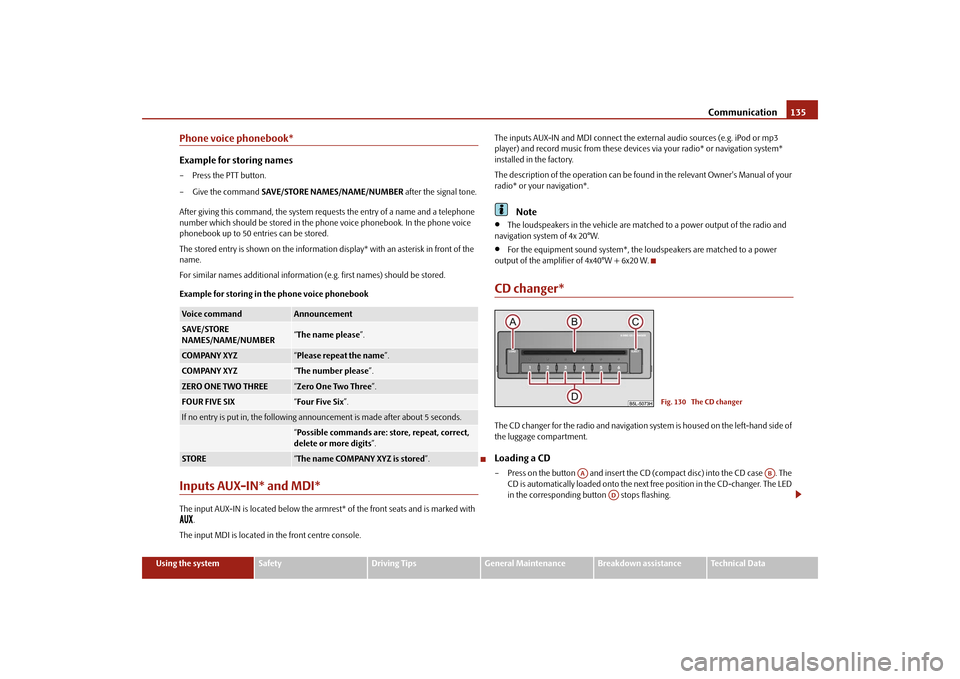
Communication
135
Using the system
Safety
Driving Tips
General Maintenance
Breakdown assistance
Technical Data
Phone voice phonebook*Example for storing names– Press the PTT button. – Give the command
SAVE/STORE NAMES/NAME/NUMBER
after the signal tone.
After giving this command, the system requests the entry of a name and a telephone number which should be stored in the phone voice phonebook. In the phone voice phonebook up to 50 entries can be stored. The stored entry is shown on the information display* with an asterisk in front of the name. For similar names additional information (e.g. first names) should be stored. Example for storing in
the phone voice phonebook
Inputs AUX-IN* and MDI*The input AUX-IN is located below the armrest* of the front seats and is marked with
.
The input MDI is located in the front centre console.
The inputs AUX-IN and MDI connect the ex
ternal audio sources (e.g. iPod or mp3
player) and record music from these device
s via your radio* or navigation system*
installed in the factory. The description of the operation can be found
in the relevant Ow
ner's Manual of your
radio* or your navigation*.
Note
•
The loudspeakers in the vehicle are matched to a power output of the radio and
navigation system of 4x 20°W.•
For the equipment sound system*, the
loudspeakers are matched to a power
output of the amplifier of 4x40°W + 6x20 W.CD changer*The CD changer for the radio and navigation sy
stem is housed on th
e left-hand side of
the luggage compartment.Loading a CD– Press on the button and insert the CD (compact disc) into the CD case . The
CD is automatically loaded onto the next
free position in the CD-changer. The LED
in the corresponding button stops flashing.
Voice command
Announcement
SAVE/STORE NAMES/NAME/NUMBER
“ The name please
”.
COMPANY XYZ
“Please repeat the name
”.
COMPANY XYZ
“The number please
”.
ZERO ONE TWO THREE
“Zero One Two Three
”.
FOUR FIVE SIX
“Four Five Six
”.
If no entry is put in, the following a
nnouncement is made af
ter about 5 seconds.
“Possible commands are: store, repeat, correct, delete or more digits
”.
STORE
“The name COMPANY XYZ is stored
”.
Fig. 130 The CD changer
AA
AB
AD
sgg.6.book Page 135 Thursday, September 24, 2009 2:32 PM
Page 137 of 271

Communication
136
Load CDs– Hold the button pressed and guide the CDs one after the other (maximum
6 CDs) into the CD case . The LEDs in
the buttons are no longer flashing.
Loading a CD to one definite position– Press on the button . The LEDs in the
buttons light up at the memory spaces,
which are already assigned and flash in the case of free memory spaces.
– Touch the desired button and
guide the CD into the CD-case .
Ejecting a CD– Briefly press on the button , in order to eject a CD. For assigned memory spaces,
now the LEDs light up in the buttons .
– Touch the corresponding bu
tton . The CD is ejected.
Ejecting all CDs– Hold the button pressed for more than 2
seconds, in order to eject the CDs. All
CDs in the CD-changer are ejected consecutively.Note
•
Always guide the CD into the CD-case
with the printed side pointing upwards.
•
Never push the CD with force into the CD-case as the insertion is performed auto-
matically.•
After loading a CD into the CD-changer, yo
u must wait until the LED of the corre-
sponding button lights up. Then the CD
-case is free to load the next CD.
•
If you have selected a position, on which
a CD is already located, this CD will be
ejected. Take out the ejected CD and load the desired CD.
AA
AB
AD
AA
AD
AD
AB
AC
AD
AD
AC
AB
AD
AB
sgg.6.book Page 136 Thursday, September 24, 2009 2:32 PM
Page 138 of 271
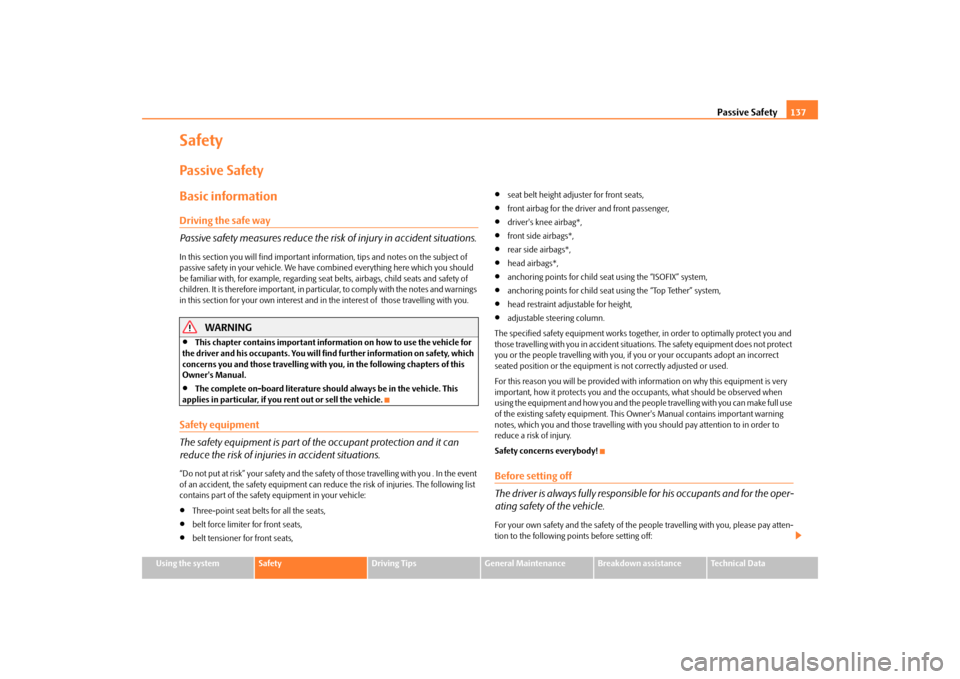
Passive Safety
137
Using the system
Safety
Driving Tips
General Maintenance
Breakdown assistance
Technical Data
SafetyPassive SafetyBasic informationDriving the safe way Passive safety measures reduce the risk
of injury in accident situations.
In this section you will find important info
rmation, tips and notes on the subject of
passive safety in your vehicle. We have
combined everything here which you should
be familiar with, for example, regarding seat
belts, airbags, child seats and safety of
children. It is therefore important, in partic
ular, to comply with the notes and warnings
in this section for your own interest and in the interest of those travelling with you.
WARNING
•
This chapter contains important information on how to use the vehicle for
the driver and his occupants. You will find further information on safety, which concerns you and those travelling with you, in the following chapters of this Owner's Manual.•
The complete on-board literature should always be in the vehicle. This
applies in particular, if you rent out or sell the vehicle.Safety equipment The safety equipment is part of the occupant protection and it can reduce the risk of injuries in accident situations.“Do not put at risk” your safety and the safety of those travelling with you . In the event of an accident, the safety equipment can redu
ce the risk of injuries. The following list
contains part of the safety
equipment in your vehicle:
•
Three-point seat belts for all the seats,
•
belt force limiter for front seats,
•
belt tensioner for front seats,
•
seat belt height adjuster for front seats,
•
front airbag for the driver and front passenger,
•
driver's knee airbag*,
•
front side airbags*,
•
rear side airbags*,
•
head airbags*,
•
anchoring points for child seat using the “ISOFIX” system,
•
anchoring points for child seat using the “Top Tether” system,
•
head restraint adjustable for height,
•
adjustable steering column.
The specified safety equipment works togeth
er, in order to optimally protect you and
those travelling with you in accident situat
ions. The safety equipment does not protect
you or the people travelling with you, if
you or your occupants adopt an incorrect
seated position or the equipment is
not correctly adjusted or used.
For this reason you will be provided with information on why this equipment is very important, how it protects you and the occupants, what should be observed when using the equipment and how you and the peop
le travelling with you can make full use
of the existing safety equipment. This
Owner's Manual contains important warning
notes, which you and those travelling with
you should pay attention to in order to
reduce a risk of injury. Safety concerns everybody!Before setting off The driver is always fully responsibl
e for his occupants and for the oper-
ating safety of the vehicle.For your own safety and the safety of the pe
ople travelling with you, please pay atten-
tion to the following points before setting off:
sgg.6.book Page 137 Thursday, September 24, 2009 2:32 PM
Page 139 of 271
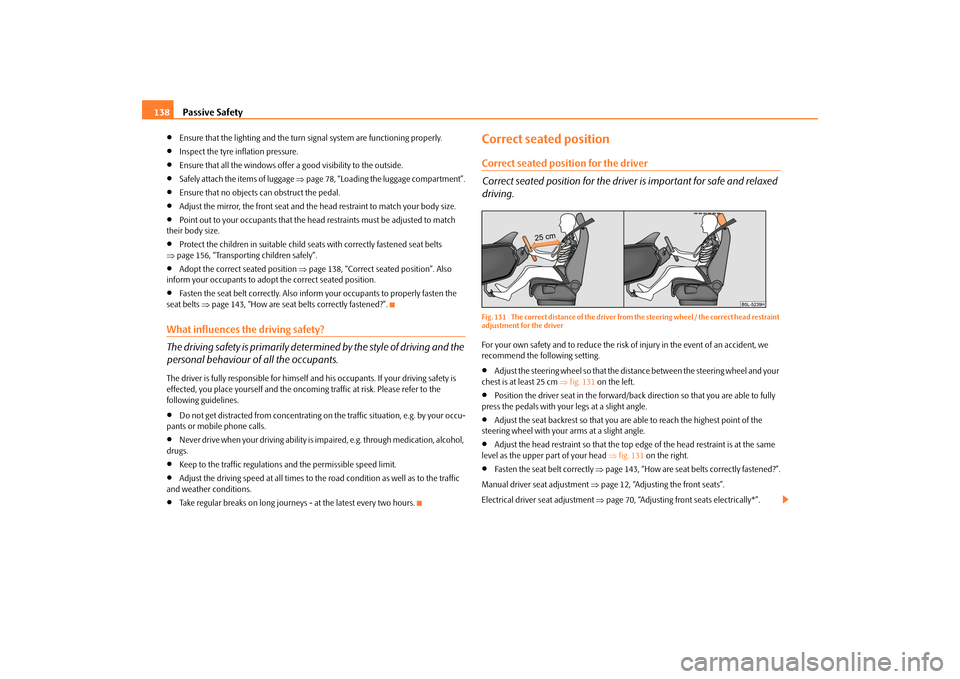
Passive Safety
138
•
Ensure that the lighting and the turn signal system are functioning properly.
•
Inspect the tyre inflation pressure.
•
Ensure that all the windows offer
a good visibility to the outside.
•
Safely attach the items of luggage
⇒page 78, “Loading the luggage compartment”.
•
Ensure that no objects can obstruct the pedal.
•
Adjust the mirror, the front seat and the head restraint to match your body size.
•
Point out to your occupants that the head
restraints must be adjusted to match
their body size.•
Protect the children in suitable child seats with correctly fastened seat belts
⇒ page 156, “Transporting children safely”.•
Adopt the correct seated position
⇒page 138, “Correct seated position”. Also
inform your occupants to adopt the correct seated position.•
Fasten the seat belt correctly. Also inform your occupants to properly fasten the
seat belts
⇒page 143, “How are seat be
lts correctly fastened?”.
What influences the driving safety? The driving safety is primarily determined by the style of driving and the personal behaviour of all the occupants.The driver is fully responsible for himself an
d his occupants. If yo
ur driving safety is
effected, you place yourself and the oncomi
ng traffic at risk. Please refer to the
following guidelines.•
Do not get distracted from concentrating on the traffic situation, e.g. by your occu-
pants or mobile phone calls.•
Never drive when your driving ability is impaired, e.g. through medication, alcohol,
drugs.•
Keep to the traffic regulations and the permissible speed limit.
•
Adjust the driving speed at all times to the road condition as well as to the traffic
and weather conditions.•
Take regular breaks on long journe
ys - at the latest every two hours.
Correct seated positionCorrect seated position for the driver Correct seated position for the driver is important for safe and relaxed driving.Fig. 131 The correct distance of
the driver from the steering wh
eel / the correct head restraint
adjustment for the driverFor your own safety and to reduce the risk of injury in the event of an accident, we recommend the following setting.•
Adjust the steering wheel so that the distance between the steering wheel and your
chest is at least 25 cm
⇒fig. 131
on the left.
•
Position the driver seat in the forward/back direction so that you are able to fully
press the pedals with your legs at a slight angle.•
Adjust the seat backrest so that you are able to reach the highest point of the
steering wheel with your arms at a slight angle.•
Adjust the head restraint so that the top edge of the head restraint is at the same
level as the upper part of your head
⇒fig. 131
on the right.
•
Fasten the seat belt correctly
⇒page 143, “How are seat belts correctly fastened?”.
Manual driver se
at adjustment
⇒page 12, “Adjusting the front seats”.
Electrical driver seat adjustment
⇒page 70, “Adjusting front seats electrically*”.
sgg.6.book Page 138 Thursday, September 24, 2009 2:32 PM
Page 140 of 271

Passive Safety
139
Using the system
Safety
Driving Tips
General Maintenance
Breakdown assistance
Technical Data
WARNING
•
The front seats and the head restraints must always be adjusted to match
the body size of the seat occupant as well as the seat belts must always be correctly fastened in order to provide an optimal protection for you and your occupants.•
The driver must maintain a distance of
at least 25 cm to
the steering wheel
⇒ page 138, fig. 131
. Not maintaining this minimum distance will mean that
the airbag system will not be able to properly protect you - hazard!•
When driving, hold the st
eering wheel with both hands firmly on the outer
edge in the 9 o'clock and 3 o'clock po
sition. Never hold
the steering wheel
firmly in the 12 o'clock position or in another way (e.g. in the middle of the steering wheel or at the inner steering wheel
edge). In such cases, injuries to the
arms, the hands and the head can occur
when the driver airbag is deployed.
•
The seat backrests must not be angled too far back when driving otherwise
this will affect proper operation of the se
at belts and of the airbag system - risk
of injury!•
Ensure that there are no objects in
the footwell as an
y objects may get
behind the pedals during a driving or
braking manoeuvre. You would then no
longer be able to operate the
clutch, to brake or accelerate.
Correct seated position for the front passenger The f ro n t p as s en ger mus t mai n tai n a d i s tan ce of a t l ea s t 25 c m f rom th e dash panel so that the airbag offers him the greatest possible safety it is deployed.For the safety of the front pass
enger and to reduce the risk of injury in the event of an
accident, we recommend
the following setting.
•
Adjust the front passenger seat as
far as possible to the rear.
•
Adjust the head restraint so that the top ed
ge of the head restraint is at the same
level as the upper pa
rt of your head
⇒page 138, fig. 131
.
•
Fasten the seat belt correctly
⇒page 143, “How are seat belts correctly fastened?”.
In exceptional cases the front pass
enger airbag can be deactivated
⇒page 154,
“Deactivating an airbag”.
Manual front passenger adjustment
⇒page 12, “Adjusting the front seats”.
Electrical front passenger seat adjustment
⇒page 70, “Adjusting front seats electri-
cally*”.
WARNING
•
The front seats and the head restraints must always be adjusted to match
the body size of the seat occupant as well as the seat belts must always be correctly fastened in order to provide an optimal protection for you and your occupants.•
The front passenger must maintain a distance of at least 25 cm to the dash
panel. Not maintaining this minimum distance will mean that the airbag system will not be able to properly protect you - hazard!•
Always keep your feet in the footwel
l when the vehicle is being driven -
never place your feet on the instrument panel, out of the window or on the surfaces of the seats. You will be exposed to increased risk of injury if it becomes necessary to apply the brake or in the ev
ent of an accident. If an airbag is
deployed, you may suffer fatal injuries wh
en adopting an incorrect seated posi-
tion!•
The seat backrests must not be angled
too far back when driving otherwise
this will affect proper operation of the se
at belts and of the airbag system - risk
of injury!Correct seated position for the occupants on the rear seats Occupants on the rear seats must sit upright, keep the feet in the foot- well and must have their se
at belts correctly fastened.
To reduce the risk of injury in the event of
a sudden braking manoeuvre or an accident,
the occupants on the rear seats must observe the following:•
Adjust the head restraints so that the top edge of the head restraints are at the same
level as the upper part of your head
⇒page 138, fig. 131
.
•
Fasten the seat belt correctly
⇒page 143, “How are seat belts correctly fastened?”.
•
If you are transporting
⇒page 156, “Transporting children safely” children in the
vehicle, please use a suitable child restraint system.
sgg.6.book Page 139 Thursday, September 24, 2009 2:32 PM